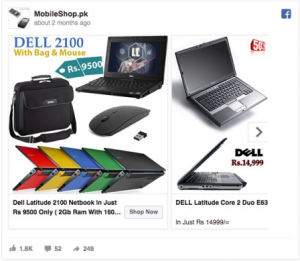Like a certain Game of Thrones character, Facebook killed off one of its leading cast members last month.
Facebook’s programmatic buying platform called Facebook Exchange or FBX, was a platform that used cookie-based data to deliver ads to users of Facebook.
This system worked by allowing “approved third-party platforms to place retargeting ads on Facebook” after that user had visited other websites. When they visited that external website, a cookie would be stored on their browser if they reached a point that signaled an intent to purchase.
If the user didn’t actually go through with their purchase, the FBX system would “bid on retargeting ads that [would have] appear[ed] in the right-hand column of Facebook when the user returns back to the social network.”
This system worked great at first, but with the ever changing market and the move to mobile, it has now found itself pushed into irrelevance. It’s taken the same journey as the VCR, with the advent of blu-ray.
So here are the four fatal flaws that were embedded within FBX, and why it shows that directly buying via Facebook or the API was always the better choice.
(1) FBX DIDN’T WORK ON MOBILE
One of the biggest reasons that FBX got the ax was that it was a desktop-only platform.
FBX couldn’t serve ads to users through Facebook’s mobile app, something you are able to do when deploying ads through Facebook’s API or ad partners. So unless you were advertising a desktop-only application, you should be interested in those mobile users.
With direct buy, you can select where to serve the customer your ad and later, which delivery location provides the best return on your ad spend.
Direct buy offers a plethora of ad delivery choices, which far surpassed what was offered via FBX.
Not only that, but Facebook is going massively mobile, with its app accounting for 91% of its daily active users. And a staggering 52% of all Facebook users access the social network solely via mobile.
So it’s safe to say, if you were using FBX, you effectively pigeonholed your campaigns to desktop users only. You were also missing out on the massive playing field of 929 million daily active users on mobile.
It’s no surprise that Facebook turned its attention to mobile, as that is where the money is made. Facebook’s mobile ad revenue currently accounts for 82% of its total advertising revenue and 79% of its total revenue overall.
(2) FBX’s USER INFO WAS LIKELY LESS RELEVANT TO YOUR BUSINESS
Even if you were in thrall to FBX, the user info generated by that platform was likely of lower quality than direct buy methods.
The issue was that FBX couldn’t differentiate between the multiple people that likely use a single desktop.
Typically, cookies placed on a desktop browser are prone to gathering information on the interests and browsing behavior of everyone who shares that computer.
So, when you got ads for Mermaid Glitter Lash Extensions on your Facebook newsfeed, you could thank FBX for that (no judgement here – just a wild guess that it’s something you’re not in the market for).
And when your mom was being constantly targeted for size 12 Carhartt work boots and she asks you why, you could again thank FBX.
FBX was powered by a network of information regarding the broad range of people who may have shared a computer. Therefore, it was often difficult for it to decipher how to deliver ads to the correct audience.
Because of this, you would have ended up with a lot of wasted inventory.
Individualization and mobile were the key factors in the ad buy equation. Not only was Facebook moving towards a user-focused level, but mobile helped push that door wide open by providing more specific user info.
The reason mobile had an influence was because most people do not share their mobile browsers with others. Further, Facebook had to catch up with a mobile-focused retargeting system to deliver dynamic ads.
Not surprisingly, sixteen year old girls aren’t letting others search on their phones. Therefore, the information generated is concentrated and the Facebook pixel can accurately determine who wants lash extensions and who wants work boots.
(3) FBX DIDN’T ALLOW FOR LOOKALIKE AUDIENCES
Facebook invested in improving their other ad options because they likely saw more opportunity for greater flexibility and options for advertisers large and small.
One of the major missing pieces was FBX’s inability to use Facebook Lookalike Audiences. This program uses the power of the Facebook pixel and other proprietary data sources you’ve acquired to take full advantage of the data you are gathering from your prospecting and retargeting campaigns.
The key is that Facebook Lookalike Audiences, through a direct buy program or platform, can use data gathered from the pixel, your CRM/email data, your Facebook page fans, or feeding in an existing customers/users to target new prospects on Facebook that appear to have similar demographic and psychographic traits to your seed audience.
Not only did FBX not allow you to interact with any of the native tools within Facebook, but the cookie FBX used did not track demographic or psychographic information. Nor did it integrate with what Facebook knows about you through your account.
So unless you were working with a team that married all the info available from your campaigns, audiences gathered through the pixel, and then added in FBX, then any data from a retargeting campaign would be irrelevant. Any information gained would still have required you to manually analyze the FBX data to target new audiences through Facebook’s API or ad tools.
And who would have had time for that?
(4) FBX’S FORMAT PALED IN COMPARISON TO DYNAMIC PRODUCT ADS
The last fatal blow to FBX came from the introduction of Dynamic Product Ads within the Facebook ad system.
When specific product ID’s from your website are viewed, added to the cart, or purchased, the DPA is auto-generated based on the template for the ad you create.
The ad template will pull relevant information from that product and your site, like the Product ID, name, description, landing page URL, image URL, and the availability, directly from your product catalog. Then it will automatically fill in the content for the ad.
Sound familiar? This is close to what FBX did. But there’s a reason why DPAs are significantly better.
Instead of simply an auto-static ad generation, with DPAs, you can create variables that implement an even smarter strategy.
Using DPAs, your ad may generate a discounted price on the item the user viewed or in dynamic carousel ads, the viewer can receive suggestions for other similar products (in the same category), in addition to the original product.
These product categories can be tailored by price, brand, and any other product segments you deploy.
You could have produced a form of dynamic ads through FBX, but there were a number of issues that made it frustrating. First, you couldn’t reach people on their mobile devices. You also wouldn’t have had access to deep linking into apps or cross-device retargeting. And you couldn’t create the dynamic product ads yourself (you had to go through an ad partner).
With all of these issues, is it no wonder that DPAs are now going strong while FBX is left in the dust?
CONCLUSION
FBX may have been great when it was first introduced, but it had been walking the path to irrelevance for awhile. Now that Facebook finally gave it the ax, direct-buy has prevailed as the better and more efficient method.
When you go with direct buying (either through an agency or on your own) instead of programmatic, like FBX, you are able to do so much more and learn a significant amount about your customers and potential customers.
Even better, you’re able to gain high-quality users and reach them where they are – on their mobiles.
While many may have mourned the death of one of the key characters on Game of Thrones, it’s safe to say that no one should be mourning the passing of FBX.
Digital & Social Articles on Business 2 Community(14)





